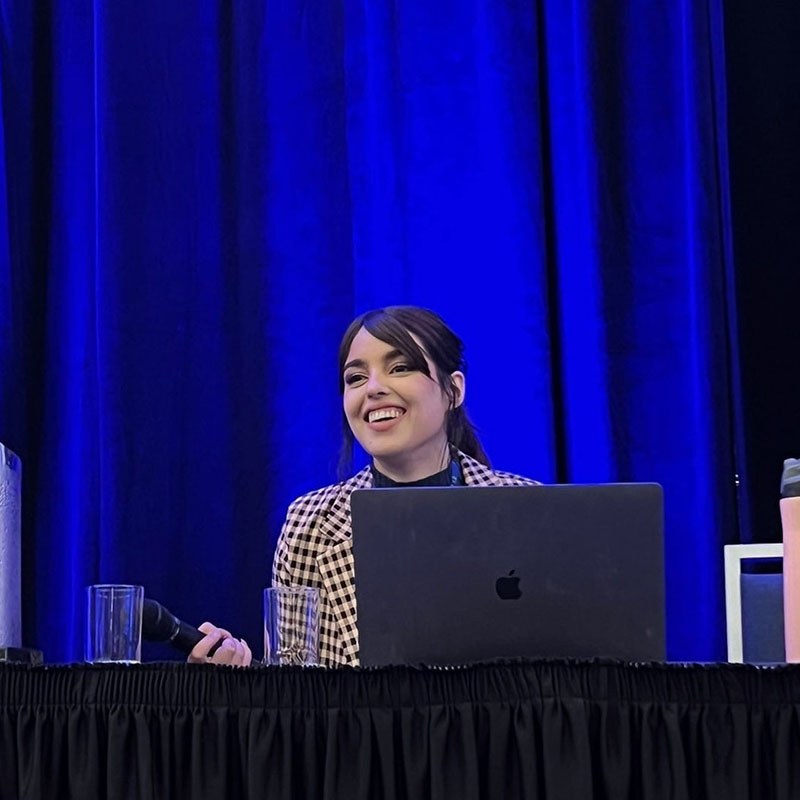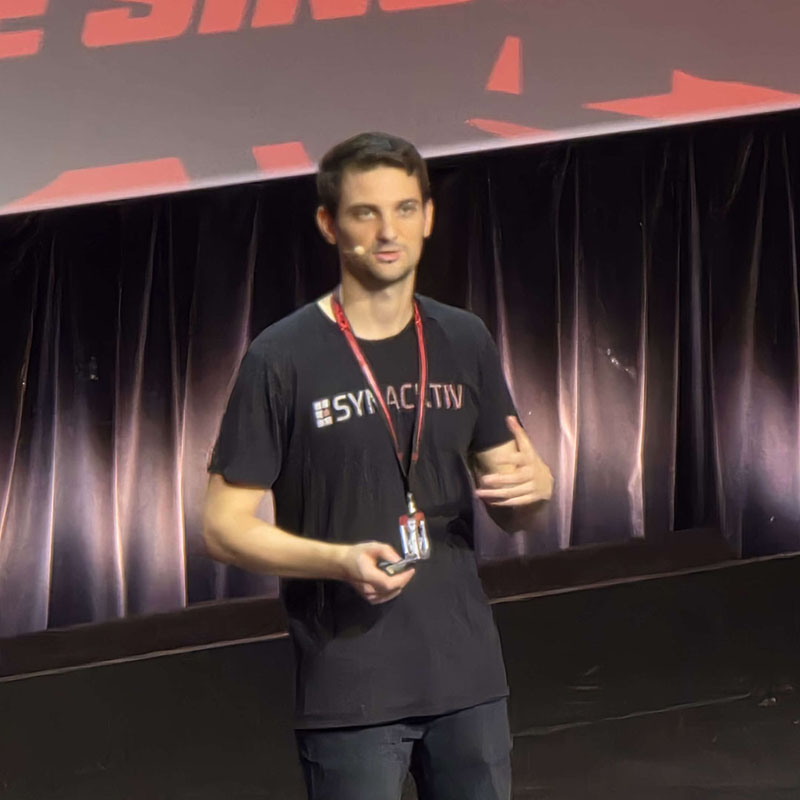TALKS & SPEAKERS
Two days of conferences | 15 talks | 20 speakers
Click on a talk to see the speaker's presentation
An RbTree Family Drama: Exploiting a Linux Kernel 0-day Through Red-Black Tree Transformations
William Liu, Savino DicanosaCUDA de Grâce: Owning AI Cloud Infrastructure with GPU exploits
Valentina Palmiotti, Samuel LovejoyNTLM reflection is dead, long live NTLM reflection: Story of an accidental Windows RCE
WilArise from the Wireless: Breaking the Security Barrier in Wi-Fi
XiaobyeBreaking the Vault: USB Bugs and Bug Bounty Failures
Sergei VolokitinCrash One - A StarBucks Story (CVE-2025-24277)
Csaba Fitzl, Gergely KalmanDéjà Vu in Linux io_uring: Breaking Memory Sharing Again After Generations of Fixes
PumpkinExploiting the Undefined: PWNing Firefox by Settling its Promises
Tao Yan, Edouard BochinFrom 2-Bit Reset to 0-Click RCE in Redis: A Pwn2Own Edition
Benny IsaacsInside Apple Secure Enclave Processor in 2025
Quentin SalingueKorean Rookie Hackers' Journey: Road to Pwn2Own with a VirtualBox Exploit
HanseoKimOpening keynote
Ivan KrstićPaint it Blue: Attacking the Bluetooth stack
Mehdi Talbi, Etienne Helluy-LafontReVault! Compromised by your Secure SoC
Philippe LaulheretWhere the shells land: a forensic perspective on in-the-wild exploitation
Donncha Ó CearbhaillAn RbTree Family Drama: Exploiting a Linux Kernel 0-day Through Red-Black Tree Transformations
Abstract
CVE-2025-38001 is the story of how we exploited a Linux network scheduler 0-day for a 82k USD bounty by creating a novel red-black tree attack technique. We find that the manipulation of red-black node metadata can achieve a pointer copy primitive through a tree rebalance, ultimately unlocking more powerful attack capabilities. Our journey begins with an infinite loop bug, which we then convert into a use-after-free. From there, we develop a reliable, data-only exploit that compromises major Linux distributions and all baseline instances of Google’s kernelCTF. We subsequently adapt our approach to also defeat the instance hardened with state-of-the-art mitigations. Finally, we break the bounty program’s proof-of-work system and achieve the quickest submission ever.
Speakers

William Liu
Bio
William Liu is a security researcher who specializes in low-level systems and computer architecture. He is a member of the Crusaders of Rust security research group as well as the DiceGang CTF team, and currently works at NVIDIA as a systems software engineer. Much of his research is documented on his personal site at willsroot.io.
William is a Class of 2025 graduate of the Massachusetts Institute of Technology, where he worked on kernel fuzzing and the EntryBleed KASLR bypass under Professor Mengjia Yan. He presented the latter discovery at HASP ‘23, where he won best paper, and NEHWS ‘24.

Savino Dicanosa
Bio
Savino Dicanosa is a security researcher specializing in low-level systems exploitation, with a focus on the Linux kernel. He is a member of the Crusaders of Rust security research group and the author of syst3mfailure.io, where he documents some of his work.
CUDA de Grâce: Owning AI Cloud Infrastructure with GPU exploits
Abstract
The explosive rise of artificial intelligence has driven unprecedented global demand for GPUs. To satisfy it, cloud providers have created Infrastructure-as-a-Service (IaaS) products specific for AI and machine learning workflows. These platforms rely on CUDA, NVIDIA’s proprietary toolkit for GPU hardware acceleration. Holding more than 90% of the datacenter GPU market, nearly every AI/ML workload runs on NVIDIA hardware, placing critical trust in its driver stack. This architecture concentrates risk, making these drivers a high commodity attack surface in the serverless cloud AI/ML ecosystem.
In this talk, IBM’s X-Force Offensive Research (XOR) unveils 0-day vulnerabilities in the NVIDIA CUDA driver stack and discuss their implications to the greater cloud security model. They detail their vulnerability discovery process, which includes a fuzzing campaign, as well as outline the exploitation techniques which bypass modern kernel mitigations (such as CONFIG_SLAB_VIRTUAL that protects against cross-cache attacks) to escape hardened containers and gain root on the host. With a single vulnerability granting kernel mode execution, attackers can escalate to root on the host and breach multi-tenant isolation, exposing the models, datasets, and credentials of every tenant sharing the GPU.
Speakers

Bio
Valentina is a security researcher, exploit developer, and low level systems hacker. She has found and exploited vulnerabilities in targets such as operating system kernels, authentication protocols, and mobile platforms. She currently leads IBM's X-Force Offensive Research (XOR), a team dedicated to advanced vulnerability research focusing on high-assurance and hardened environments.

Bio
Sam Lovejoy is a security researcher at IBM X-Force Offensive Research (XOR), where he specializes in reverse engineering and vulnerability research. His main research interests are in fuzzing, microarchitectural attacks, and low-level security. Prior to working at IBM, Sam studied malware reverse engineering during his BS and MS at Georgia Tech.
NTLM reflection is dead, long live NTLM reflection: Story of an accidental Windows RCE
Abstract
For nearly two decades, Windows has been plagued with NTLM reflection vulnerabilities. This special case of NTLM authentication relay has historically led to local privilege escalation or even remote command execution, although with some limitations. Over time, mitigations against this class of vulnerability were implemented, leading to a false assumption that NTLM reflection attacks were relics of the past. This presentation will shatter that assumption by covering the research that led to the discovery of CVE-2025-33073, a logical vulnerability leading to authenticated RCE as SYSTEM on almost any Windows machine and without any user interaction.
In this talk, fundamental concepts about authentication relay attacks will be explained, as well as the context surrounding the research and the accidental discovery of the vulnerability. Afterwards, a methodical investigation of the root cause of the vulnerability will be presented, first by analysing network captures and then by performing a thorough reverse-engineering of LSASS internals and its NTLM authentication provider.
Subsequently, we will shift our attention to Kerberos, where we will demonstrate that CVE-2025-33073 is not restricted to NTLM and that it also affects Kerberos. After a brief reminder of the protocol, in-depth insights in its integration within LSASS will be discussed as well as an undocumented behavior, to understand why this vulnerability also applies to Kerberos.
Finally, the patch analysis will be presented. We will detail how it fixes the specific attack vector described in this presentation and how it may not be enough to completely eradicate this class of vulnerability. We will conclude by explaining how the exploitation of this vulnerability could have been prevented even before it was found and the current state Windows machine hardening.
Speakers

Wil
SynacktivBio
Wilfried Bécard is a hacker and researcher working at Synacktiv. With a particular interest in Active Directory and Azure exploitation, his passion lies in uncovering new techniques to enhance cybersecurity in these areas. Constantly experimenting, testing, and collaborating with the security community, he aims at constantly improving his knowledge in these fields.
Arise from the Wireless: Breaking the Security Barrier in Wi-Fi
Abstract
Wi-Fi has become the backbone of modern IoT communication and is now found in a wide range of devices such as smartphones, in-vehicle infotainment systems, smart cameras, smart TVs, and home routers. If attackers uncover vulnerabilities in Wi-Fi implementations, they can launch indiscriminate attacks against any Wi-Fi device, disrupting or even taking control of your daily life.
Until now, attacks on Wi-Fi devices often required Wi-Fi passphrase to join the private network before launching any attack. However, our in-depth analysis of MediaTek’s Wi-Fi implementation uncovered multiple “shortcuts” allowing hackers to gain control without authentication. Notably, a frame injection vulnerability was discovered that allows unauthenticated attackers to skip pairwise master key validation and gain private network access. And what’s more, we dug deeper and uncovered vulnerabilities in MediaTek’s Wi-Fi frame processing that allows nearby attackers to achieve remote code exeuction without requiring a Wi-Fi passphrase.
In this talk, we will present Wi-Fi architecture alongside practical techniques for reverse-engineering and exploiting it. Attendees will learn how to analyze custom instructions, use debugging tools, and leverage public resources to reconstruct MediaTek’s Wi-Fi chipset architecture. We will cover authentication bypass, frame-parsing flaws, and Wi-Fi 7 vulnerabilities, demonstrating how each can be used to compromise Wi-Fi devices. By the end of the session, attendees will have mastered a repeatable methodology for uncovering and exploiting Wi-Fi vulnerabilities.
Speakers

Bio
Wei-Che Kao, also known as Xiaobye (@xiaobye_tw), is a security researcher at DEVCORE, focusing primarily on wireless security. His previous research on Bluetooth Low Energy was accepted to USENIX Security.
Breaking the Vault: USB Bugs and Bug Bounty Failures
Abstract
Hardware wallets are designed to provide a secure environment for managing cryptocurrency assets, isolating critical secrets from potentially compromised user systems. Due to the nature of the assets being protected, vendors come up with various security features to protect the private keys from physical, remote and supply chain attacks. However, what if a simple USB communication flaw could render these protections meaningless?
This talk presents a critical vulnerability in the Cypherock X1 hardware wallet, where an out-of-bounds write in the USB packet processing logic leads to a full compromise of the device.
We will walk through the discovery process, root cause analysis, and exploitation techniques, demonstrating how a malicious USB payload can extract a user’s private keys in real-time while they interact with the wallet. A live Proof-of-Concept (PoC) will showcase how malware on a user’s PC can invisibly steal funds, highlighting the urgent need for hardware wallet vendors to implement rigorous input validation and memory safety checks.
Speakers

Sergei Volokitin
HexplotBio
Sergei Volokitin is an independent security researcher at Hexplot with the focus on embedded security and mobile devices. He has a number of publications on Smart Card attacks and conference presentations on mobile device and hardware security.
Crash One - A StarBucks Story (CVE-2025-24277)
Abstract
On a cold, sunny autumn day, we sat down with Gergely in a Starbucks to brainstorm a few ideas for vulnerability research. We quickly found out that we both identified a vulnerability which we both thought was not possible to exploit. While we talked through it, we realized that it might be possible, and that is when our journey started in developing an exploit. We will walk through the entire exploit development process, and how we managed to overcome each obstacle one by one. In our talk we will cover sandbox extensions, XPC calls, reverse XPC calls, ACL inheritance and file system race conditions. This was all needed to gain LPE and escape the sandbox using a vulnerability in osanalyticshelper, which is now identified as CVE-2025-24277.
Speakers

Csaba Fitzl
KandjiBio
Csaba Fitzl graduated in 2006 as a computer engineer. He worked for 6 years as a network engineer, troubleshooting and designing big networks. After that, he worked for 8 years as a blue and red teamer focusing on network forensics, malware analysis, adversary simulation, and defense bypasses. Then he moved on to the macOS world and developed a "macOS Exploitation and Penetration Testing" training at OffSec. Currently he works as a Principal macOS Security Researcher at Kandji. He gave talks and workshops at various international IT security conferences, including Hacktivity, BlackHat, Troopers, SecurityFest, DEFCON, and Objective By The Sea. Csaba spends his free time with his family, hikes and runs in the mountains.

Gergely Kalman
Bio
Gergely is an independent security researcher, spending most of his time on Apple's Bug Bounty program. As an ex-sysadmin and programmer he is adept at Linux, Python and C and he specializes in logic vulnerabilities, often involving filesystems or file APIs. He publishes his findings at https://gergelykalman.com
Déjà Vu in Linux io_uring: Breaking Memory Sharing Again After Generations of Fixes
Abstract
Introduced in 2019 to enhance asynchronous I/O performance, Linux’s io_uring subsystem initially faced multiple vulnerabilities stemming from its inherent complexity. While io_uring was briefly enabled in kCTF, it was later quarantined over security concerns pending further hardening efforts. Over time, continuous patches and refinements have significantly improved its security. Google even experimentally re-enabled it in a limited-time kernelCTF promotion to evaluate its robustness. While only two 0-days were identified during the event, lingering design flaws suggest that io_uring’s security story is far from over.
One vulnerability reflecting this ongoing fragility is CVE-2025-21836, a race condition triggered during memory mapping. While it may appear to be a straightforward race at first glance, it in fact results from generations of security patches in shared memory management. Fixes for lifetime mismanagement and locking inconsistencies led to RCU misuse, which was later patched with reference count protections — inadvertently introducing another racy object update. Furthermore, these vulnerabilities share recurring kernel bug patterns that are often mishandled, highlighting systemic design flaws that repeatedly cause regressions, even in mature subsystems like io_uring.
In this presentation, I will first introduce Linux io_uring, describing its memory-sharing mechanism and I/O buffer design. Following that, I will explain how historical patches cumulatively led to CVE-2025-21836, which I discovered during kernelCTF. I will also share the exploitation details, including techniques to make the restricted race condition more reliably exploitable. Finally, I will conclude with a discussion of the difficulties in maintaining shared memory: challenges that are not easily resolved through shallow patching in the modern kernel.
Speakers

Bio
Chih-Yen Chang, aka Pumpkin (@u1f383), is a security researcher at DEVCORE. His work primarily focuses on Linux kernel, Android and hypervisor security. He has participated in Pwn2Own competitions multiple times, successfully compromising targets such as Synology NAS, Ubuntu and RHEL. He was also a speaker at POC 2024 and HITCON CMT 2025.
Exploiting the Undefined: PWNing Firefox by Settling its Promises
Abstract
Some vulnerabilities remain deeply hidden within systems for years. Sometimes, even when discovered, they are considered unexploitable due to their restrictive primitives. This presentation discusses a unique exploit targeting Firefox that was demonstrated at Pwn2Own Berlin 2025, showcasing how deeply hidden and seemingly unexploitable vulnerabilities can be transformed into reliable exploits through innovative exploitation techniques.
We’ll explore how connecting similar implementation issues for the JavaScript (JS) Promise specification across different browsers revealed a six-year-old Firefox vulnerability. This approach can be extended to other JS specifications to uncover further hidden vulnerabilities. We’ll also present a novel technique for exploiting undefined fields in SpiderMonkey JS engine objects to creatively convert a highly restricted out-of-bounds write (OOBW) primitive into a use-after-free (UAF), ultimately achieving type confusion for more powerful exploitation primitives. Furthermore, we’ll detail state-of-the-art heap grooming and garbage collection manipulation techniques specifically tailored for SpiderMonkey heaps. In addition to all that, we’ll introduce a novel, universal method for faking arbitrary objects in SpiderMonkey without requiring object shape addresses to be leaked, a technique with broad applicability across SpiderMonkey-based exploits.
Speakers

Bio
Tao Yan (@Ga1ois) is a security researcher at Palo Alto Networks. He likes discovering new attack surfaces, exploring new research ideas and deep diving into system internals from both offensive and defensive perspectives. His interests include bug findings with dynamic fuzzing and static code analysis, exploits, mitigations bypass, sandbox escape and privilege escalation on various applications and OS components. He has also been involved with exploits, APTs, malware detection and defense. He has been listed as #7 and #4 researcher in 2016 and 2017 for MSRC Most Valuable Researchers. He is also the winner of the Windows local escalation of privilege category in Pwn2Own 2021, the Chrome/MSEdge browser category in Pwn2Own 2024 and the Firefox browser category in Pwn2Own 2025. He has achieved the Pwnie Awards for Most Innovative Research in 2024. In addition, he is a regular security patent inventor and security conference speaker including Black Hat (USA, EU, Asia, MEA), CanSecWest, BlueHat, VirusBulletin, ReCon, POC, HITCON, etc.

Bio
Edouard Bochin (@le_douds) is a security researcher at Palo Alto Networks who specializes in vulnerability research on both offensive and defensive fronts. He is the recipient of the 2024 Pwnie Award for Most Innovative Research and is a two-time Pwn2Own winner, PWNing Chrome and MSEdge browsers at Pwn2Own Vancouver 2024 and Firefox browser at Pwn2Own Berlin 2025. He is also a patent inventor and has notably spoken at Black Hat USA 2024 and Virus Bulletin 2023.
From 2-Bit Reset to 0-Click RCE in Redis: A Pwn2Own Edition
Abstract
At Pwn2Own Berlin 2025, we demonstrated a critical UAF vulnerability in Redis’s Lua interpreter that has existed for 15 years. This vulnerability exploits an UAF that resets 2 bits, enabling arbitrary code execution with a 100% success rate.
In this presentation, we will detail how the UAF vulnerability was leveraged to gain arbitrary read capabilities, perform object faking, and ultimately achieve arbitrary code execution. Notably, the exploit successfully bypassed modern security mitigations such as ASLR, PointerGuard, and CET.
This session will outline the precise steps and techniques used to craft a reliable exploit.
Speakers

Bio
Security Researcher @Wiz
Inside Apple Secure Enclave Processor in 2025
Abstract
The Secure Enclave Processor is the cryptographic coprocessor of the iPhone which handles sensitive information like user data encryption or biometrics. SEP is designed to be independent from the main processor, with its own separate bootrom as well as dedicated peripherals (such as an AES engine). Public information about SEP is scarce and outdated, mainly because it is one of the few firmware Apple still encrypts today.
This presentation intends to fill the gap in knowledge and dive into the security features added by Apple over the years.
This includes:
- Pointer Authentication Code (PAC) to prevent control-flow hijacking
- SEP patches to fix potential vulnerabilities in the SEPROM
- Trusted Boot Monitor to ensure only the SEPROM code can execute at start
Speakers

Quentin Salingue
SynacktivBio
Quentin Salingue is a security researcher at Synacktiv. He is interested in all things iOS from the bootloader to the kernel. When he is not reversing Apple stuff, he tries to understand how not to make IDA crash.
Korean Rookie Hackers' Journey: Road to Pwn2Own with a VirtualBox Exploit
Abstract
This talk explores how rookie hackers are trained and grow within Korea’s security ecosystem, and how our team collaborated to tackle a complex vulnerability in the VirtualBox virtualization platform.
We provide a brief overview of VirtualBox’s architecture and attack surface, then detail the vulnerability’s unique characteristics, the custom exploit primitive we developed, and the technical challenges we overcame.
The talk concludes with how our exploit led to a successful win at Pwn2Own 2025.
Speakers

HanseoKim
Bio
Han-seo Kim is an undergraduate student majoring in Software at Ajou University and an intern at HSPACE. His primary research interests are vulnerability analysis in OS internals and virtualization, as well as red teaming.
In 2025, as a member of Team PrisonBreak, he won the VirtualBox category at Pwn2Own Berlin and obtained multiple additional CVEs.
Opening keynote
Abstract
Speakers

Bio
Head of Security Engineering+Architecture (SEAR) at Apple.
Paint it Blue: Attacking the Bluetooth stack
Abstract
Bluetooth has always been considered as an attractive target since it is present almost everywhere (TV, automotive charger, connected fridge) and especially on mobile devices as it runs as a privileged process with potential access to microphone, address book, etc.
In september and october 2023, Android published security bulletins that fixed critical vulnerabilities in their Bluetooth stack (Fluoride) that could lead to remote code execution.
The CVE-2023-40129 is an integer overflow vulnerability in the GATT protocol that does not require prior authentication with the target device.
The vulnerability is quite challenging to exploit as the integer overflow leads to a 64 KB overflow that acts like a tsunami devastating every objects in its path leading to a crash of the Bluetooth daemon.
Recently, at OffensiveCon 2025, the Android Red Team at Google behind the discovery of the bugs presented a PoC exploit for a sibling vulnerability targeting Pixel devices. However their exploit assumes the ASLR is disabled and the attacker is already paired with the target device. Attempting to exploit Fluoride looked like a fun challenge to the authors, who managed to exploit it without those assumptions
and successfully got remote code execution.
During this talk, the authors will present several Bluetooth features such as ERTM transmission mode and congestion that offer interesting primitives to shape the heap, preventing the 64 KB overflow from crashing the process. More precisely, they will detail their exploitation strategy for both Android native
allocators: Scudo and Jemalloc. Finally, they will showcase a demo of the exploit to get remote code execution (interactive shell) over Bluetooth on Samsung and Xiaomi devices.
Speakers

Mehdi Talbi
SynacktivBio
Mehdi Talbi, PhD, is a computer security researcher at Synacktiv. His main interests are vulnerability research and exploit development with a focus on Linux and Android. His previous bio was usurped by North Korea. The original is way better than the copy.

Etienne Helluy-Lafont
SynacktivBio
Etienne Helluy-Lafont, PhD, is a security researcher working at Synacktiv. His main
research topics are kernels and wireless stacks. He likes reading XNU's code,
but his laptop is running Linux.
ReVault! Compromised by your Secure SoC
Abstract
We all love security, right? And when we trust a security component to safeguard our most valuable assets such as passwords, key material and biometrics, we want to believe they’re doing a good job at it. But what happens when this assumption is flawed, and the chip that was going to protect our assets turns against us?
In this talk we’ll present the ReVault attack that targets the ControlVault3 module embedded in over 100 different laptops models from Dell. We will demonstrate how a low privilege user can fully compromise the chip, plunder its secrets, gain persistence on its application firmware and even hack Windows back. Are you ready for the heist?
Speakers

Philippe Laulheret
Cisco TalosBio
Philippe Laulheret is a Senior Vulnerability Researcher at Cisco Talos. With a focus on Reverse Engineering and Vulnerability Research, Philippe uses his background in Embedded Security and Software Engineering to poke at complex systems and get them to behave in interesting ways. Philippe presented multiple projects covering hardware hacking, reverse engineering and exploitation at DEF CON, Hardwear.io, Eko Party and more. In his spare time, Philippe enjoys playing CTFs, immersing himself in the beauty of the Pacific Northwest, and exploring the realm of Creative Coding. Philippe holds a MSc in Computer Science from Georgia Tech and a MSc in Electrical and Computer Engineering from Supélec (France).
Where the shells land: a forensic perspective on in-the-wild exploitation
Abstract
KEYNOTE
Speakers

Bio
Donncha Ó Cearbhaill (@DonnchaC) is a security researcher and head of the Security Lab at Amnesty International. For over a decade, he has led cutting-edge technical and forensic investigations to expose sophisticated spyware campaigns and other digital threats targeting journalists, activists, and human rights defenders worldwide.
In recent years, Amnesty International's Security Lab has helped uncover more than a dozen in-the-wild exploits targeting iOS, Chrome, Android, and the Linux kernel, in many cases from forensic investigations on the devices of targeted individuals. These forensics findings continue to inform new security defenses, including Apple's Lockdown Mode and Google's Advanced Protection mode for Android.
Landmark investigations from the team including the Pegasus Project and the Predator Files have contributed to the growing global awareness and conversation on the ethics and responsibilities of the offensive cyber industry.
Prepare your venue at Hexacon
Brace yourselves, it is going to be amazing
Reserve your place
Trainings
Agenda